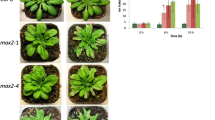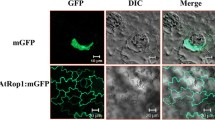Abstract
ROPs (also called RACs) are RHO-like monomeric G-proteins of plants, well-known as molecular switches in plant signal transduction processes, which are involved in plant development and a variety of biotic and abiotic stress responses. The barley (Hordeum vulgare) ROPs RACB, RAC1 and RAC3 have been shown to be involved in cellular growth, polarity and in susceptibility to the biotrophic barley powdery mildew fungus Blumeria graminis f.sp. hordei. We produced transgenic tobacco (Nicotiana tabacum) plants expressing constitutively activated (CA) mutants of the barley ROPs RACB and RAC3 to monitor the impact of heterologous ROP expression on cell polarity and disease susceptibility of tobacco. CA HvROPs influenced leaf texture, disturbed root hair polarity and induced cell expansion in tobacco. Both barley ROPs induced super-susceptibility to the compatible powdery mildew fungus Golovinomyces cichoracearum but only CA HvRAC3 induced super-susceptibility to the bacterial leaf pathogen Pseudomonas syringae pv. tabaci. Data suggest involvements of ROPs in tobacco cell expansion, polar growth and in response to bacterial and fungal leaf pathogens.





Similar content being viewed by others

Abbreviations
- Bgh :
-
Blumeria graminis f.sp. hordei
- CA:
-
constitutively-activated
- DN:
-
dominant-negative
- Pst :
-
Pseudomonas syringae pv. tabaci
References
An, Q., Hückelhoven, R., Kogel, K. H., & van Bel, A. J. E. (2006). Multivesicular bodies participate in a cell wall-associated defence response in barley leaves attacked by the pathogenic powdery mildew fungus. Cellular Microbiology, 8, 1009–1019. doi:10.1111/j.1462-5822.2006.00683.x.
Bloch, D., Lavy, M., Efrat, Y., Efroni, I., Bracha-Drori, K., Abu-Abied, M., et al. (2005). Ectopic expression of an activated RAC in Arabidopsis disrupts membrane cycling. Molecular Biology of the Cell, 16, 1913–1927. doi:10.1091/mbc.E04-07-0562.
Brembu, T., Winge, P., Bones, A. M., & Yang, Z. A. (2006). RHOse by any other name: a comparative analysis of animal and plant Rho GTPases. Cell Research, 16, 435–445. doi:10.1038/sj.cr.7310055.
Carol, R. J., Takeda, S., Linstead, P., Durrant, M. C., Kakesova, H., Derbyshire, P., et al. (2005). A RhoGDP dissociation inhibitor spatially regulates growth in root hair cells. Nature, 438, 1013–1016. doi:10.1038/nature04198.
Chen, C. Y., Cheung, A. Y., & Wu, H. M. (2003). Actin-depolymerizing factor mediates Rac/Rop GTPase-regulated pollen tube growth. The Plant Cell, 15, 237–249. doi:10.1105/tpc.007153.
Foreman, J., Demidchik, V., Bothwell, J. H., Mylona, P., Miedema, H., Torres, M. A., et al. (2003). Reactive oxygen species produced by NADPH oxidase regulate plant cell growth. Nature, 422, 442–446. doi:10.1038/nature01485.
Fu, Y., Li, H., & Yang, Z. (2002). The ROP2 GTPase controls the formation of cortical fine F-actin and the early phase of directional cell expansion during Arabidopsis organogenesis. The Plant Cell, 14, 777–794. doi:10.1105/tpc.001537.
Fu, Y., Gu, Y., Zheng, Z., Wasteneys, G., & Yang, Z. (2005). Arabidopsis interdigitating cell growth requires two antagonistic pathways with opposing action on cell morphogenesis. Cell, 120, 687–700. doi:10.1016/j.cell.2004.12.026.
Horsh, R., Fry, J., Hoffman, H., Eicholts, D., Rogers, S., & Fraley, R. (1985). Simple and general method for transferring genes into plants. Science, 277, 1229–1231.
Jones, M. A., Raymond, M. J., Yang, Z., & Smirnoff, N. (2007). NADPH oxidase-dependent reactive oxygen species formation required for root hair growth depends on ROP GTPase. Journal of Experimental Botany, 58, 1261–1270. doi:10.1093/jxb/erl279.
Jones, M. A., Shen, J. J., Fu, Y., Li, H., Yang, Z., & Grierson, C. S. (2002). The Arabidopsis Rop2 GTPase is a positive regulator of both root hair initiation and tip growth. The Plant Cell, 14, 763–776. doi:10.1105/tpc.010359.
Jung, Y. H., Agrawal, G. K., Rakwal, R., Kim, J. A., Lee, M. O., Choi, P. G., et al. (2006). Functional characterization of OsRacB GTPase—a potentially negative regulator of basal disease resistance in rice. Plant Physiology and Biochemistry, 44, 68–77. doi:10.1016/j.plaphy.2005.12.001.
Kawasaki, T., Koita, H., Nakatsubo, T., Hasegawa, K., Wakabayashi, K., Takahashi, H., et al. (2006). Cinnamoyl-CoA reductase, a key enzyme in lignin biosynthesis, is an effector of small GTPase Rac in defense signaling in rice. Proceedings of the National Acadamemy of Sciences of the U. S. A., 103, 230–235.
Kay, S., Hahn, S., Marois, E., Hause, G., & Bonas, U. (2007). A bacterial effector acts as aplant transcription factor and induces a cell size regulator. Science, 318, 648–651. doi:10.1126/science.1144956.
Kobayashi, Y., Kobayashi, I., Funaki, Y., Fujimoto, S., Takemoto, T., & Kunoh, H. (1997). Dynamic reorganization of microfilaments and microtubules is necessary for the expression of non-host resistance in barley coleoptile cells. The Plant Journal, 11, 525–537. doi:10.1046/j.1365-313X.1997.11030525.x.
Kost, B., Lemichez, E., Spielhofer, P., Hong, Y., Tolias, K., Carpenter, C., et al. (1999). Rac homologues and compartmentalized phosphatidylinositol 4, 5-bisphosphate act in a common pathway to regulate polar pollen tube growth. The Journal of Cell Biology, 145, 317–330. doi:10.1083/jcb.145.2.317.
Kost, B. (2008). Spatial control of Rho (Rac-Rop) signaling in tip-growing plant cells. Trends in Cell Biology, 18, 119–127. doi:10.1016/j.tcb.2008.01.003.
Kwon, C., Bednarek, P., & Schulze-Lefert, P. (2008). Secretory pathways in plant immune responses. Plant Physiology, 147, 1575–1583. doi:10.1104/pp. 108.121566.
Lee, Y. J., & Yang, Z. (2008). Tip growth: signaling in the apical dome. Current Opinion in Plant Biology, 11, 662–671. doi:10.1016/j.pbi.2008.10.002.
Langen, G., Imani, J., Altincicek, B., Kieseritzky, G., Kogel, K. H., & Vilcinskas, A. (2006). Transgenic expression of gallerimycin, a novel anti fungal insect defensin from the greater wax moth Galleria mellonella, confers resistance to pathogenic fungi in tobacco. Biological Chemistry, 387, 549–557. doi:10.1515/BC.2006.071.
Moeder, W., Yoshioka, K., & Klessig, D. F. (2005). Involvement of the small GTPase Rac in the defense responses of tobacco to pathogens. Molecular Plant-Microbe Interactions, 18, 116–124. doi:10.1094/MPMI-18-0116.
Molendijk, A. J., Bischoff, F., Rajendrakumar, C. S., Friml, J., Braun, M., Gilroy, S., et al. (2001). Arabidopsis thaliana Rop GTPases are localized to tips of root hairs and control polar growth. The EMBO Journal, 20, 2779–2788. doi:10.1093/emboj/20.11.2779.
Morel, J., Fromentin, J., Blein, J. P., Simon-Plas, F., & Elmayan, T. (2004). Rac regulation of NtrbohD, the oxidase responsible for the oxidative burst in elicited tobacco cell. The Plant Journal, 37, 282–293.
Murashige, T., & Skoog, F. (1962). A revised medium for rapid growth and bioassay with tobacco tissue culture. Physiologia Plantarum, 15, 473–497. doi:10.1111/j.1399-3054.1962.tb08052.x.
Ono, E., Wong, H. L., Kawasaki, T., Hasegawa, M., Kodama, O., & Shimamoto, K. (2001). Essential role of the small GTPase Rac in disease resistance of rice. Proceedings of the National Academy of Sciences of the United States of America, 98, 759–764. doi:10.1073/pnas.021273498.
Opalski, K. S., Schultheiss, H., Kogel, K. H., & Hückelhoven, R. (2005). The receptor-like MLO protein and the RAC/ROP family G-protein RACB modulate actin reorganization in barley attacked by the biotrophic powdery mildew fungus Blumeria graminis f.sp. hordei. The Plant Journal, 41, 291–303. doi:10.1111/j.1365-313X.2004.02292.x.
Pathuri, I. P., Zellerhoff, N., Schaffrath, U., Hensel, G., Kumlehn, J., Kogel, K. H., et al. (2008). Constitutively activated barley ROPs modulate epidermal cell size, defense reactions and interactions with fungal leaf pathogens. Plant Cell Reports, 27, 1877–1887. doi:10.1007/s00299-008-0607-9.
Schiene, K., Puhler, A., & Niehaus, K. (2000). Transgenic tobacco plants that express an antisense construct derived from a Medicago sativa cDNA encoding a Rac-related small GTP-binding protein fail to develop necrotic lesions upon elicitor infiltration. Molecular & General Genetics, 263, 761–770. doi:10.1007/s004380000248.
Schultheiss, H., Dechert, C., Kogel, K. H., & Hückelhoven, R. (2002). A Small GTP-binding host protein is required for entry of powdery mildew fungus into epidermal cells of barley. Plant Physiology, 128, 1447–1454. doi:10.1104/pp. 010805.
Schultheiss, H., Dechert, C., Kogel, K. H., & Hückelhoven, R. (2003). Functional analysis of barley RAC/ROP G-protein family members in susceptibility to the powdery mildew fungus. The Plant Journal, 36, 589–560. doi:10.1046/j.1365-313X.2003.01905.x.
Tao, L. Z., Cheung, A. Y., & Wu, H. M. (2002). Plant Rac-like GTPases are activated by auxin and mediate auxin-responsive gene expression. The Plant Cell, 14, 2745–2760. doi:10.1105/tpc.006320.
Wong, H. L., Pinontoan, R., Hayashi, K., Tabata, R., Yaeno, T., Hasegawa, K., et al. (2007). Regulation of rice NADPH oxidase by binding of Rac GTPase to its N-terminal extension. The Plant Cell, 19, 4022–4034. doi:10.1105/tpc.107.055624.
Yang, Z., & Fu, Y. (2007). ROP/RAC GTPase signaling. Current Opinion in Plant Biology, 10, 490–494. doi:10.1016/j.pbi.2007.07.005.
Zheng, Z. L., & Yang, Z. (2000). The Rop GTPase: an emerging signaling switch in plants. Plant Molecular Biology, 44, 1–9. doi:10.1023/A:1006402628948.
Acknowledgements
We are grateful to Jörg Vogelsberg (University of Giessen) for support of the tissue culture growth of plant material, to Caroline Hoefle (Technische Universität München) for help with statistical data analysis and to Holger Schultheiss (University of Giessen) for plant genotyping. This work was supported by the German Research Foundation (FOR666, HU886/1), the University of Agricultural and Natural Resources, College of Agriculture, Department of Plant Protection, Sari, Iran and by the German Academic Exchange Service.
Author information
Authors and Affiliations
Corresponding author
Rights and permissions
About this article
Cite this article
Pathuri, I.P., Imani, J., Babaeizad, V. et al. Ectopic expression of barley constitutively activated ROPs supports susceptibility to powdery mildew and bacterial wildfire in tobacco. Eur J Plant Pathol 125, 317–327 (2009). https://doi.org/10.1007/s10658-009-9484-5
Received:
Accepted:
Published:
Issue Date:
DOI: https://doi.org/10.1007/s10658-009-9484-5



